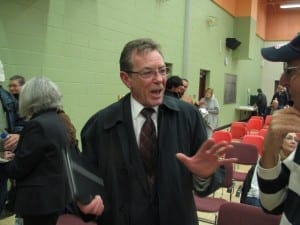Mississauga has chosen to avoid high-rise condominiums along the Mississauga waterfront
In recent weeks I’ve attended three community events in two cities. In each case, I attended the event toward the end, after much of it was over.
Mimico 20/20 Open House, Nov. 8, 2012
I arrived as the meeting was wrapping up. The City of Toronto planning staff were welcoming and friendly, a quality that I remember from a previous Mimico 20/20 public meeting.
Subsequently, I have heard that there is a feeling among some community participants that the information shared represented a ‘top-down’ approach to the planning process, was lacking in key information, and provided a too-short timeline for community responses. I will comment on this topic further when more information from the community is available.
Lakeview Ratepayers Association
In the previous week, I attended the tail end of the annual general meeting of the Lakeview Ratepayers Association, held at a seniors’ centre in Mississauga.

Mississauga Councillor Jim Tovey continues discussion at end of Lakeview Ratepayers Association AGM, October 2012. Jaan Pill photo
I was very impressed. Councillor Jim Tovey, who began his career in politics when he was president of the latter association, as I understand, spoke at the meeting of how he envisions future attractiveness and prosperity — he’s looking 25 years down the road — in Lakeview, driven by the fact that Mississauga has made a conscious decision to avoid high-rise condos along the Mississauga waterfront. Instead the focus is on mid-rise development along arterial routes, as I understand.
That approach stands in contrast, by way example, with the wall of condos emerging on the Humber Bay shoreline in Toronto.
The energy in the room was very high and very positive. The rapport between Tovey and the audience was readily apparent. I’m pleased I live close to the Mississauga border so I can see how things are framed in Mississauga. Comparisons are useful as they expand our conceptions of what is possible.
Islington Ratepayers and Residents Association
This too was an impressive meeting. It was held in a Toronto District School Board school. I had the sense that in this particular community, people had been coming to such meetings for many years. They’re keeping the conversations going. Among the speakers was Ward 5 Councillor Peter Peter Milczyn. He gave thoughtful answers to questions and spoke cogently of the wider, City-wide context in which planning decisions are made.
I very much like the fact this association welcomes and speaks on behalf of both ‘ratepayers’ and ‘residents.’ The tradition of emphasizing the ‘ratepayers’ as custodians of the decision making process in the community goes back a long way in world history; it’s wonderful that in Islington the views of ‘residents’ are also taken into account.
Capital Improvements at Marie Curtis Park
I’ve been following community affairs only for a couple of years, since learning in October 2010 that Parkview School in Long Branch was for sale.
One of my ongoing interests concerns how community input regarding development projects works out in practice. That is, a question that invariably arises is: What do we mean when we speak of meaningful community input?
I was impressed with what I’ve seen regarding community input as it relates to Marie Curtis Park, which is close to where I live. Early on, the community communicated that a planned relocation of a parking lot was a source of concern. This was a key topic during an early stage of discussion. In response to community input, the parking lot plans were changed. I was impressed, and inspired. Meaningful community input has been evident in subsequent stages of capital improvements in the park as well.
The Colonel Samuel Smith Ice Trail story has similarities. The initial proposed footprint for the outdoor facility, near Kipling Avenue and Lake Shore Blvd. West, was met with community objections. Those objections were taken into account in the final configuration of the footprint. It’s turned out to be a successful project.
What matters are the practical results of ongoing discussions. What matters are the results on the ground. That’s what punctuates the discussion, and brings it to its conclusion.
Stormwater Management in South Etobicoke
I recall attending a meeting connected with Stormwater Management in South Etobicoke. That was quite a meeting. The residents communicated quite strongly held views expressing the conclusion that an earlier proposal would benefit from major revision.
Although it remains to be seen, I had the sense that City of Toronto planning officials may take those views into account. The residents at the meeting spoke in favour of a solution that includes an environmentally sensitive focus, as contrasted to one that emphasizes a large-scale ‘engineered’ solution. I look forward to following the next stage of that particular consultation process.
I also look forward as well to seeing how things work out in Lakeview. From what I’ve seen to date, I’m impressed. I will be following with interest to see how things work out on the ground, and along the waterfront, in Mississauga and in Toronto.

Leave a Reply
Want to join the discussion?Feel free to contribute!